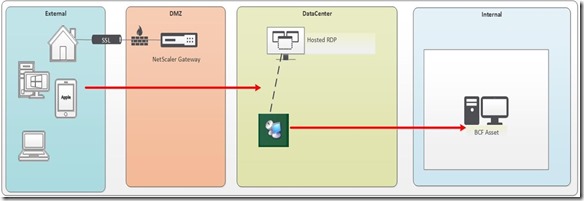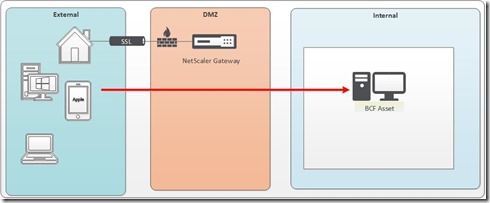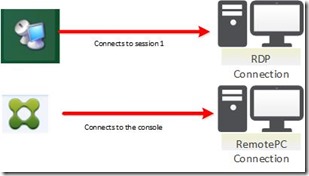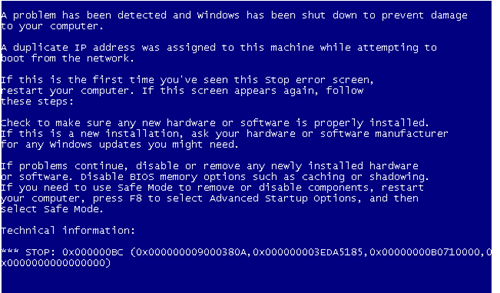To ensure our XenDesktops are up and functional for the day I have created a morning check script perform this task. The check will look for:
- UNREGISTERED MACHINES
- REGISTERED MACHINES
- MACHINES IN MAINTENANCE MODE
Ideally we will only see machines that in the REGISTERED category. Here is the PowerShell script that was created and run from the Desktop Delivery Controller
Reference
XenDesktop Monitoring: Desktop Availability
http://blogs.citrix.com/2012/10/27/xendesktop-monitoring-desktop-availability/
|
#
# XenDesktop Monitoring: Desktop Availability
# Created March 1 2013 – Trevor Svienson
# Written by – Miguel Contreras Citrix
# Load Citrix PowerShell modules
#
# Set-ExecutionPolicy RemoteSigned
#
# Load the XenDesktop Snapins
#
Asnp Citrix.*
#
# Check VMs that failed to reboot
#
$badVMs = Get-BrokerDesktop -PowerActionPending $false -PowerState On -SummaryState Available -WillShutdownAfterUse $true -MaxRecordCount 5000
If ($badVMs)
{
foreach($vm in $badVMs)
{
New-BrokerHostingPowerAction -MachineName $vm.HostedMachineName -Action ‘Reset’
}
}
#
#Check for VMs in maint mode and unregistered, and send email report
#
$recipients = "alert.citrix@svi-virtualsolutions.com"
$fromEmail = "XenDesktopProd@svi-virtualsolutions.com"
$server = "mail.svi-virtualsolutions.com"
$time = Get-Date ?format d
[string]$unregisteredVMs = (Get-BrokerDesktop -MaxRecordCount 5000 | ? {($_.RegistrationState -eq ‘Unregistered’) -and ($_.PowerState -eq ‘On’)} | select HostedMachineName,DesktopGroupName,LastDeregistrationReason | ft -wrap -autosize | Out-String)
[string]$registeredVMs = (Get-BrokerDesktop -MaxRecordCount 5000 | ? {($_.RegistrationState -eq ‘Registered’) -and ($_.PowerState -eq ‘On’)} | select HostedMachineName,DesktopGroupName,LastDeregistrationReason | ft -wrap -autosize | Out-String)
[string]$maintenanceModeVMs = (Get-BrokerDesktop -MaxRecordCount 5000 | ? {$_.InMaintenanceMode -eq ‘True’} | select HostedMachineName,DesktopGroupName,LastDeregistrationReason | ft -wrap -autosize | Out-String)
[string]$emailBody = "UNREGISTERED MACHINES `n`n`n $unregisteredVMs" + "REGISTERED MACHINES `n $registeredVMs" + "`n" + "MACHINES IN MAINTENANCE MODE `n $maintenanceModeVMs"
#
#Send it off
#
send-mailmessage -from $fromEmail -to $recipients -subject "XenDesktop Prod Daily Check $currentTime" -body $emailBody
|
Here is the end result via email:
|
UNREGISTERED MACHINES
REGISTERED MACHINES
HostedMachineName DesktopGroupName LastDeregistrationR
eason
—————– —————- ——————-
WINDOWS764MCS01 MCS – Pooled Windows 7 x64 AgentShutdown
WINDOWS764MCS02 MCS – Pooled Windows 7 x64 AgentShutdown
WINDOWS764MCS03 MCS – Pooled Windows 7 x64 AgentShutdown
WINDOWS764MCS04 MCS – Pooled Windows 7 x64 AgentShutdown
WINDOWS764MCS05 MCS – Pooled Windows 7 x64 AgentShutdown
WINDOWS764MCS06 MCS – Pooled Windows 7 x64 AgentShutdown
WINDOWS7UAT999 MCS – Windows 7 x64 – Master AgentShutdown
WINDOWS764NPX001 VDI – Windows 7 x64 – AssetGen Prod AgentShutdown
WINDOWS764NPX002 VDI – Windows 7 x64 – AssetGen Dev AgentShutdown
WINDOWSMCS101 MCS – Pooled Windows XP x86 AgentShutdown
WINDOWSMCS103 MCS – Pooled Windows XP x86 AgentShutdown
WINDOWSMCS104 MCS – Pooled Windows XP x86 AgentShutdown
WINDOWSMCS105 MCS – Pooled Windows XP x86 AgentShutdown
WINDOWSMCS107 MCS – Pooled Windows XP x86 AgentShutdown
WINDOWSMCS108 MCS – Pooled Windows XP x86 AgentShutdown
WINDOWSMCS998 MCS – Windows XP x86 – Master ContactLost
WINDOWSVDIPRD001 VDI – Windows XP x86 – Image Now AgentShutdown
WINDOWSVDIPRD002 VDI – Windows XP x86 ContactLost
MACHINES IN MAINTENANCE MODE
HostedMachineName DesktopGroupName LastDeregistrationR
eason
—————– —————- ——————-
WINDOWSMCS107 MCS – Pooled Windows XP x86 AgentShutdown
WINDOWSMCS108 MCS – Pooled Windows XP x86 AgentShutdown
|
The script calls CheckForVMsInMTCMode.ps1 is located on the DDC in C:\tools folder. The script is run as a scheduled task which launches at 7 am daily.
Here is how the task is configured on the DDC:
Inside the daily task this is the Action. Simply launches PowerShell and then a command argument for launching the file:
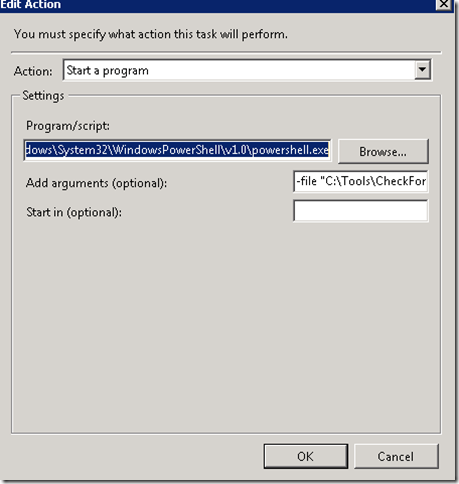
Here is a more closer look at the argument:
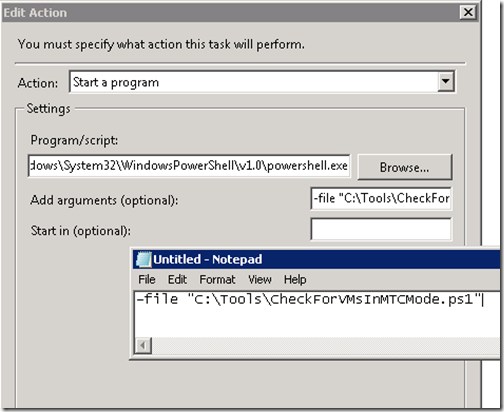
Also remember to add the "rights" to run the file.

Testing the Script
In order to get this to work I ran some tests to see if this would work. A good references to do this is
Weekend Scripter: Use the Windows Task Scheduler to Run a Windows PowerShell Script
http://blogs.technet.com/b/heyscriptingguy/archive/2012/08/11/weekend-scripter-use-the-windows-task-scheduler-to-run-a-windows-powershell-script.aspx
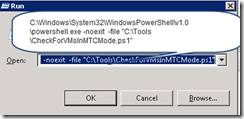
From the DDC I opened a run command and typed this
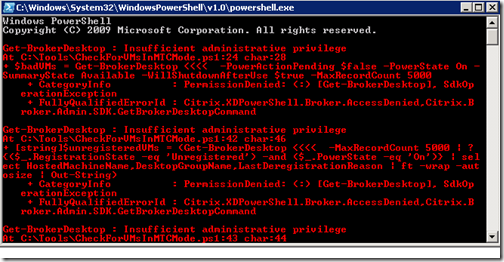
As you can see from the screen cap above I was receiving an "Insufficient administrative privilege" message which simply meant I did not have enough privileges to run the XenDesktop cmdlet. I had to elevate my privileges in order for this to complete from the run command. I also had to do the same in the daily task:

Another reference to run PowerShell from a daily task.
Run PowerShell Scripts from Task Scheduler
http://community.spiceworks.com/how_to/show/17736-run-powershell-scripts-from-task-scheduler











